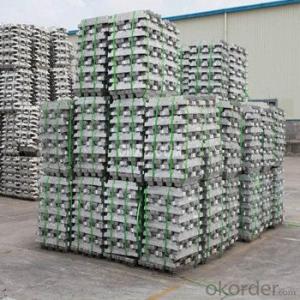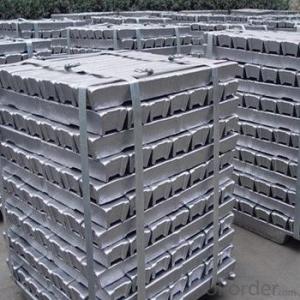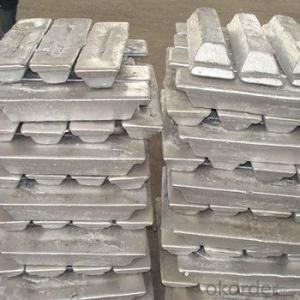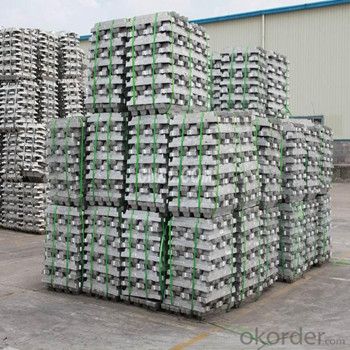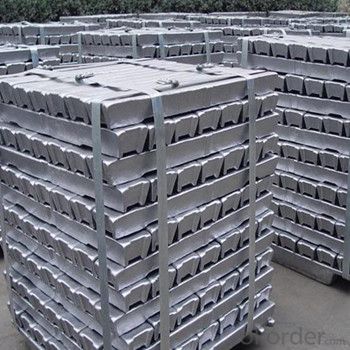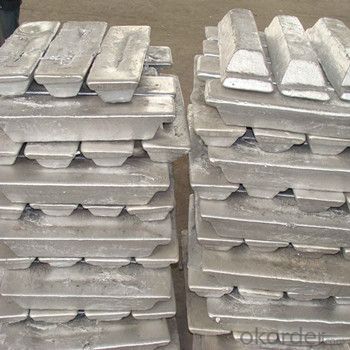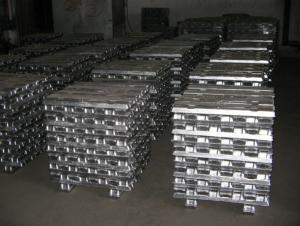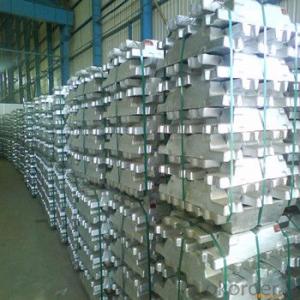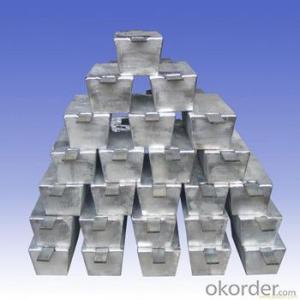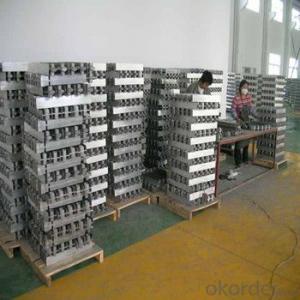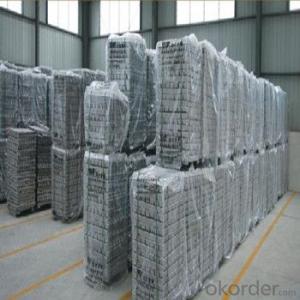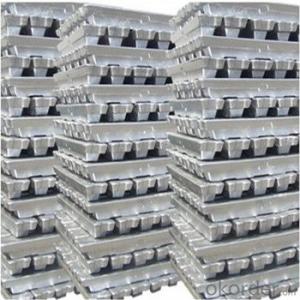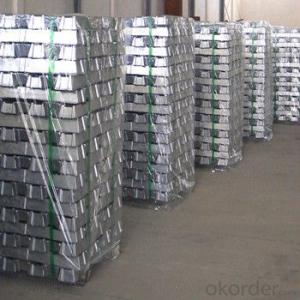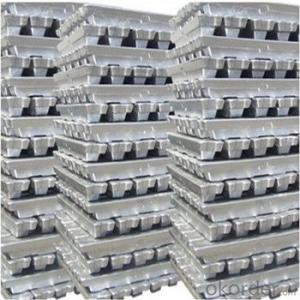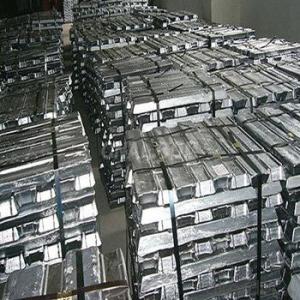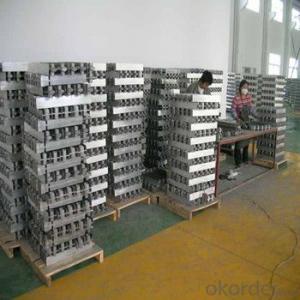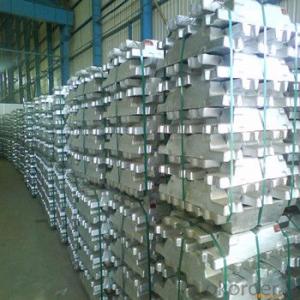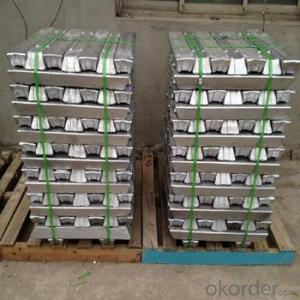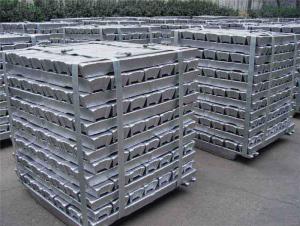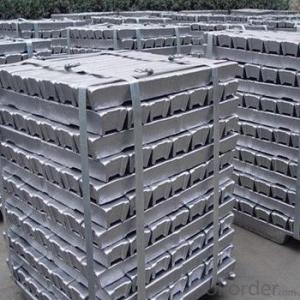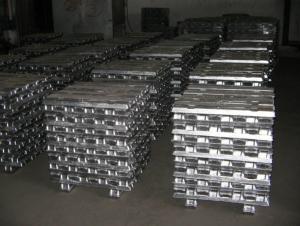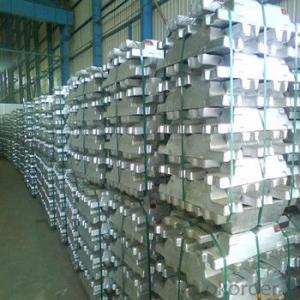Aluminum Pig/Ingot 2015 Hot Sale Products
- Loading Port:
- China main port
- Payment Terms:
- TT OR LC
- Min Order Qty:
- 1 m.t.
- Supply Capability:
- 100000 m.t./month
OKorder Service Pledge
OKorder Financial Service
You Might Also Like
Pure Aluminum Pig/Ingot Used for Industry
1.Structure of Aluminum Pig/Ingot
A material that has been cast into a shape in order to be transported and processed easier than in an unprocessed form. An ingot is typically rectangular in shape, which allows it to be stacked. Ingots are most commonly associated with metals, with ingots of gold held in the vaults of banks and brokerages being popular images.
Aluminum Ingot is with the AL as the main chemical composition.Aluminum Ingot is used for industry,such as automobile,pinning and weaving,electron broadly and so on. Aluminum Ingot has the following advantages: easy control and operation, fast melting.
2.Main Features of the Aluminum Pig/Ingot
•High Purity
•Easy control and operation
•High strength
•Fast melting
•Competitive price
•Best Service
3.Aluminum Pig/Ingot Images
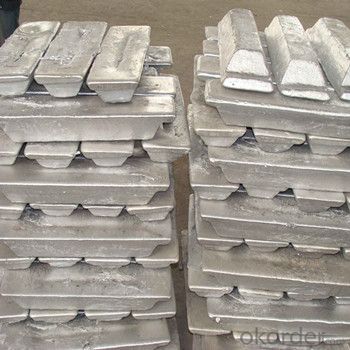
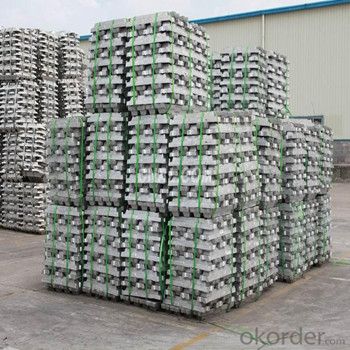
4.Aluminum Pig/Ingot Specification
Grade | Chemical Composition % | |||||||||
Al≥ | impurities ≤ | |||||||||
Si | Fe | Cu | Ga | Mg | Zn | Mn | others | Sum | ||
Al99.9 | 99.90 | 0.50 | 0.07 | 0.005 | 0.02 | 0.01 | 0.025 | - | 0.010 | 0.10 |
Al99.85 | 99.85 | 0.80 | 0.12 | 0.005 | 0.03 | 0.02 | 0.030 | - | 0.015 | 0.15 |
Al99.7 | 99.70 | 0.10 | 0.20 | 0.010 | 0.03 | 0.02 | 0.030 | - | 0.030 | 0.30 |
Al99.6 | 99.60 | 0.16 | 0.25 | 0.010 | 0.03 | 0.03 | 0.030 | - | 0.030 | 0.40 |
Al99.5 | 99.50 | 0.22 | 0.30 | 0.020 | 0.03 | 0.05 | 0.050 | - | 0.030 | 0.50 |
Al99.00 | 99.00 | 0.42 | 0.50 | 0.020 | 0.03 | 0.05 | 0.050 | - | 0.050 | 1.00 |
5.FAQ of Aluminum Pig/Ingot
We have organized several common questions for our clients,may help you sincerely:
①How about your company?
A big and famous and professional manufacturer & supplier of Aluminum Pig/Ingot, is one of the one of the large-scale professional investment Aluminum Pig/Ingot production bases in China.It have focuses on producing the Aluminum Pig/Ingot production for many years and gotten rich experience.Annually lagrge amount of Aluminum Pig/Ingot production are exported to markets in Europe,America and Japan. The quality and service have also gotten OEM service is available according to customer’s requirements.
②How to guarantee the quality of the products?
We have established the international advanced quality management system,every link from raw material to final product we have strict quality test;We resolutely put an end to unqualified products flowing into the market. At the same time, we will provide necessary follow-up service assurance.
③How long can we receive the product after purchase?
In the purchase of product within three wo We have organized several common questions for our clients,may help you sincerely:
①How about your company?
A big and famous and professional manufacturer & supplier of Aluminum Pig/Ingot, is one of the one of the large-scale professional investment Aluminum Pig/Ingot production bases in China.It have focuses on producing the Aluminum Pig/Ingot production for many years and gotten rich experience.Annually lagrge amount of Aluminum Pig/Ingot production are exported to markets in Europe,America and Japan. The quality and service have also gotten OEM service is available according to customer’s requirements.
②How to guarantee the quality of the products?
We have established the international advanced quality management system,every link from raw material to final product we have strict quality test;We resolutely put an end to unqualified products flowing into the market. At the same time, we will provide necessary follow-up service assurance.
③How long can we receive the prod rking days, We will arrange the factory delivery as soon as possible. The pecific time of receiving is related to the state and position of customers.Commonly 7 to 10 working days can be served.
- Q: Does the pure aluminium ingot need to be removed in addition to the slag after melting?
- Specific look at the accuracy of your die-casting, strict requirements can not be removed, reducing costs, more competitive
- Q: How are aluminum ingots used in the production of architectural structures?
- Due to their numerous advantageous properties, aluminum ingots find widespread usage in the production of architectural structures. They serve as the raw material for manufacturing various aluminum products, such as beams, columns, façades, and roofing systems. One of the primary rationales for employing aluminum ingots in architectural structures lies in their lightweight nature. Aluminum is considerably lighter than conventional construction materials like steel or concrete. This characteristic facilitates the transportation, handling, and installation of finished architectural components, thereby reducing overall construction time and costs. In addition, aluminum ingots possess exceptional corrosion resistance. When exposed to the elements, aluminum develops a natural oxide layer that shields it from rust and decay. This property ensures the longevity and visual appeal of architectural structures made from aluminum ingots, even in harsh environments. The versatility of aluminum ingots also plays a pivotal role in architectural applications. Aluminum can be readily extruded, cast, or molded into various shapes and profiles, enabling architects and designers to fashion unique and intricate structures. This flexibility allows for the production of custom-made components that fulfill specific design requirements, thereby enhancing the aesthetic appeal of the structures. Furthermore, aluminum ingots offer excellent thermal and electrical conductivity. This feature proves particularly advantageous in architectural structures as it facilitates efficient energy transfer and distribution. Aluminum components can be seamlessly integrated into heating, ventilation, and air conditioning systems, ensuring optimal energy efficiency and cost savings. Moreover, aluminum ingots demonstrate high sustainability and environmental friendliness. Aluminum is 100% recyclable without compromising its original properties, making it the preferred choice for eco-conscious architects and builders. By incorporating aluminum ingots into architectural structures, the construction industry can significantly reduce its carbon footprint and contribute to a more sustainable future. In conclusion, the many benefits of aluminum ingots, including their lightweight nature, corrosion resistance, versatility, thermal and electrical conductivity, and sustainability, make them highly suitable for the production of durable, visually appealing, and energy-efficient architectural structures that meet the demanding requirements of modern architecture.
- Q: What are the properties of aluminum ingots that make them suitable for construction?
- Aluminum ingots possess several properties that make them highly suitable for construction purposes. Firstly, aluminum is a lightweight material, weighing approximately one-third of the weight of steel. This characteristic makes it easier and more cost-effective to transport and handle during construction projects. Despite its lightweight nature, aluminum is also remarkably strong, offering a high strength-to-weight ratio. This property allows for the construction of sturdy and durable structures, capable of withstanding various loads and environmental conditions. Another significant property of aluminum ingots is their excellent corrosion resistance. Aluminum forms a natural oxide layer on its surface, which acts as a protective barrier against moisture, chemicals, and other corrosive elements. This resistance to corrosion ensures that aluminum structures remain intact and maintain their structural integrity over extended periods. Aluminum ingots are also known for their malleability and ductility. These properties make it easy to shape and mold the material into various forms and designs, enabling architects and engineers to create intricate and aesthetically pleasing structures. Additionally, aluminum can be easily fabricated, welded, and joined, allowing for flexibility in construction techniques and facilitating efficient installation processes. Furthermore, aluminum is a highly sustainable material. It is 100% recyclable without losing its inherent properties. This recyclability not only reduces the environmental impact of construction projects but also contributes to cost savings and resource conservation. Lastly, aluminum ingots have excellent thermal and electrical conductivity. This feature makes aluminum an ideal choice for construction projects that require efficient heat transfer, such as in heating, ventilation, and air conditioning systems, or electrical conductivity, as in wiring and electrical components. In conclusion, the properties of aluminum ingots, including their lightweight, strength, corrosion resistance, malleability, recyclability, and conductivity, make them highly suitable for construction. These properties contribute to the creation of durable, aesthetically pleasing, and environmentally friendly structures.
- Q: What are the main factors influencing the choice between aluminum ingots and aluminum slabs?
- The choice between aluminum ingots and aluminum slabs can be influenced by several factors. Firstly, the production process plays a crucial role. Ingots are commonly used for casting and shaping purposes due to their easy meltability and moldability. On the other hand, slabs are often utilized in rolling and extrusion processes to create thin sheets or various shapes. Secondly, the specific requirements of the end product can impact the decision. If the final product needs a particular shape or thickness, slabs may be preferred as they can be directly processed into the desired dimensions. However, if the product requires casting into complex shapes, ingots may be more suitable. Moreover, cost considerations also come into play. Ingots are generally cheaper to produce as they require less processing and have fewer quality requirements. Conversely, slabs may involve additional steps like rolling or extrusion, which can increase production costs. Market demand is another essential factor. If there is a higher demand for products derived from slabs, such as sheet metal or extruded profiles, then slabs would be preferred to meet the market needs efficiently. Additionally, the available production capacity and resources of a manufacturer can influence the decision. If a company has the necessary machinery and capabilities to process aluminum slabs efficiently, it may choose slabs over ingots to maximize its production capacity and resources. In conclusion, manufacturers must carefully evaluate the production process, product requirements, cost considerations, market demand, and available resources to make an informed decision regarding the use of aluminum ingots or slabs. By considering these factors, they can align their production capabilities with market demands effectively.
- Q: How are aluminum ingots used in the production of automotive parts?
- The automotive industry relies heavily on aluminum ingots as they serve as the raw material for manufacturing lightweight and long-lasting components. Aluminum's use in this industry has gained significant traction due to its exceptional properties, such as its high strength-to-weight ratio, resistance to corrosion, and efficient thermal conductivity. Once obtained, aluminum ingots undergo a series of manufacturing processes to convert them into automotive parts. Initially, the ingots are melted in a furnace, resulting in molten aluminum. This liquid metal is then poured into a mold or cast, giving it the desired shape for the automotive part. This casting process allows for the production of intricate designs and complex shapes that would be challenging to achieve with other materials. Following the casting process, the newly formed automotive part undergoes additional treatments to enhance its mechanical properties. These treatments may include heat treatment, surface finishing, and machining. Heat treatment improves the material's strength and hardness, while surface finishing processes like polishing or coating provide a visually pleasing appearance and smooth texture. Machining processes such as milling, drilling, and cutting are also performed to ensure precise dimensions and a perfect fit within the vehicle. Aluminum ingots are commonly employed in the production of various automotive parts, including engine blocks, cylinder heads, pistons, wheels, transmission cases, and structural components. The lightweight nature of aluminum allows for reduced vehicle weight, resulting in enhanced fuel efficiency and reduced emissions. Furthermore, aluminum's excellent thermal conductivity aids in dissipating heat generated by the engine, contributing to improved overall performance and longevity. In conclusion, aluminum ingots are vital in the production of automotive parts due to their lightweight, durable, and corrosion-resistant properties. Through the casting, heat treatment, surface finishing, and machining processes, these ingots are transformed into high-quality components that are crucial to the automotive industry's pursuit of efficiency, performance, and sustainability.
- Q: How can aluminium ingots be cast into aluminium plates?
- Aluminum ingot is not suitable for casting aluminium plate directly. Even if the aluminum plate can be directly cast, its mechanical performance is not good, uneven thickness, poor surface quality.
- Q: Can aluminum ingots be used in 3D printing?
- Yes, aluminum ingots can be used in 3D printing. Aluminum is a commonly used material in additive manufacturing due to its lightweight, high strength, and excellent thermal conductivity. However, instead of directly using aluminum ingots, a process called powder bed fusion, specifically selective laser melting (SLM) or electron beam melting (EBM), is utilized. In this process, fine aluminum powder is spread in thin layers and selectively melted by a laser or electron beam, layer by layer, to create the desired 3D object. This allows for the production of complex geometries and precise parts with high strength and accuracy.
- Q: Ask the relevant matters you master the scrap aluminum ingot casting of aluminum, which is divided into several, if the recycled scrap aluminum ingot casting to join what!
- Alloy aluminum is nothing more than doors and windows and so on, and raw aluminum is mostly mechanical, regardless of, such as automobiles, motorcycles, machine casings, pistons and so on. Soft, tough, tough aluminum. Very crisp. If you don't understand, you'd better not do it. Some things are losing money in aluminium smelting.
- Q: I would like to ask, aluminum water poured into the mold, what should pay attention to? Aluminum solidification in the mold after the aluminum ingot, how can I get it out?
- Cast aluminium is divided into casting and die casting. In general, mold parting agent shall be applied in the mold cavity.
- Q: How are aluminum ingots shaped into different forms?
- The process of aluminum extrusion involves shaping aluminum ingots into various forms. First, the ingot is heated until it becomes molten. Then, the molten aluminum is forced through a specially designed die, which determines the final product's shape and size. The die, acting as a mold, is a hollow profile with the desired shape. Once the molten aluminum passes through the die, it undergoes a cooling process to solidify it into the desired shape. Cooling methods such as air cooling or water quenching can be used, depending on the product's specific requirements. After the aluminum has cooled and solidified, it is cut to the desired length. This can be done during or after the extrusion process, depending on the shape's complexity or the product's requirements. Aluminum extrusion offers a wide range of possibilities for shape production, including solid profiles, hollow sections, tubes, and intricate designs. This highly versatile and efficient process is a popular choice for shaping aluminum into different forms. Moreover, aluminum's lightweight and corrosion-resistant properties make it an ideal material for various applications, ranging from the construction and automotive industries to consumer goods and electronics.
Send your message to us
Aluminum Pig/Ingot 2015 Hot Sale Products
- Loading Port:
- China main port
- Payment Terms:
- TT OR LC
- Min Order Qty:
- 1 m.t.
- Supply Capability:
- 100000 m.t./month
OKorder Service Pledge
OKorder Financial Service
Similar products
Hot products
Hot Searches
Related keywords
